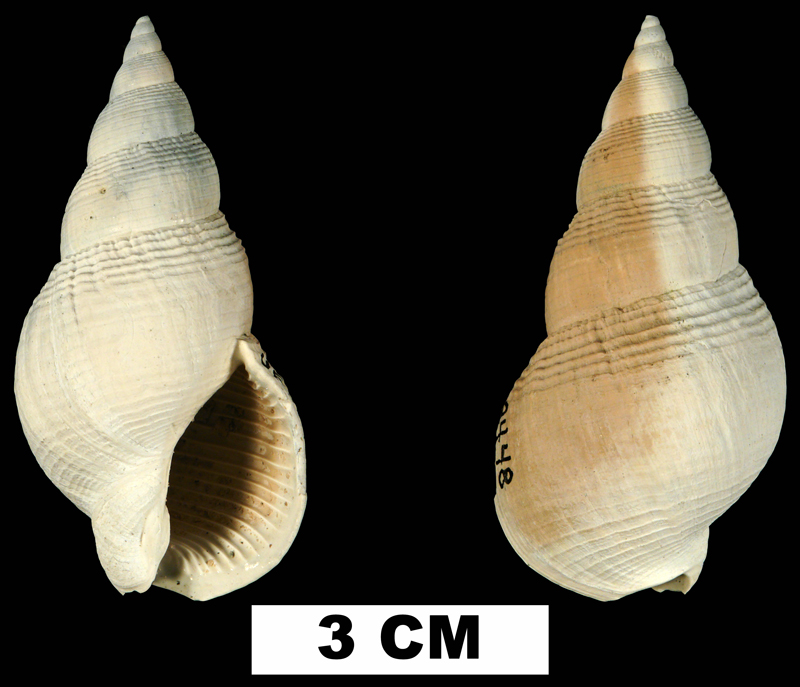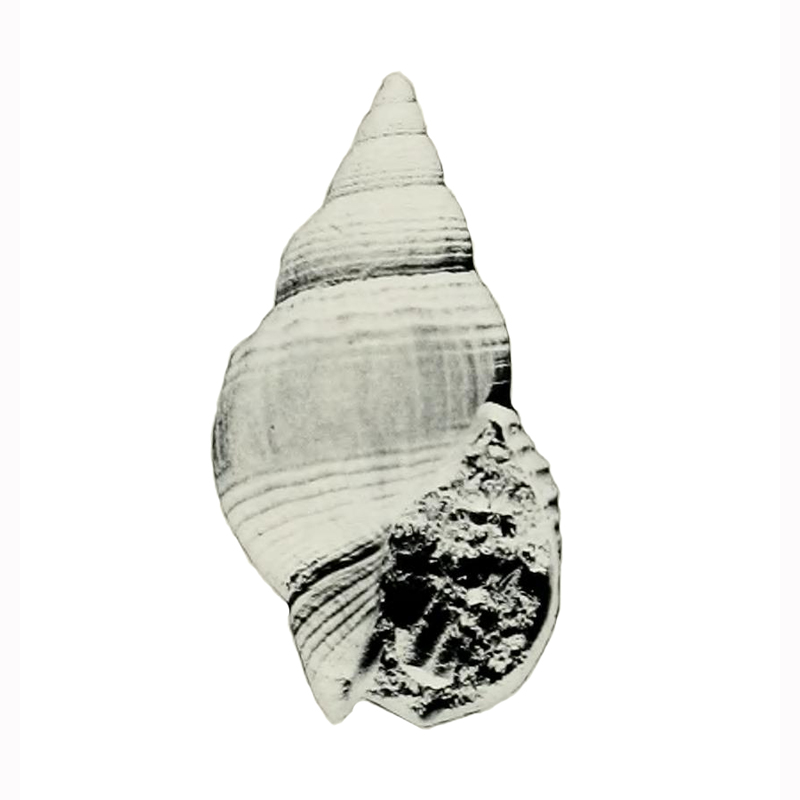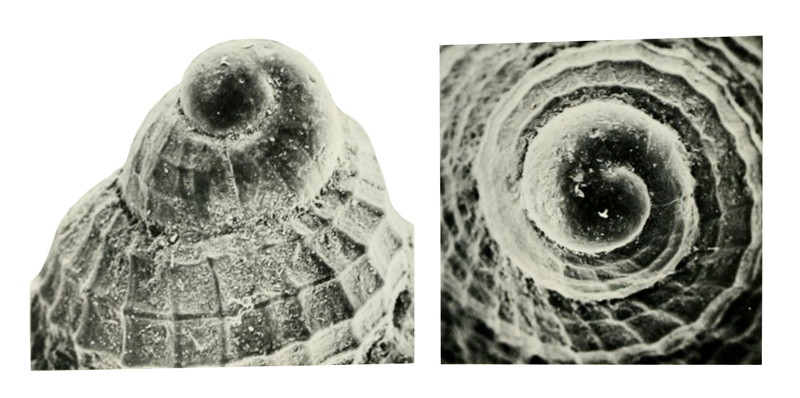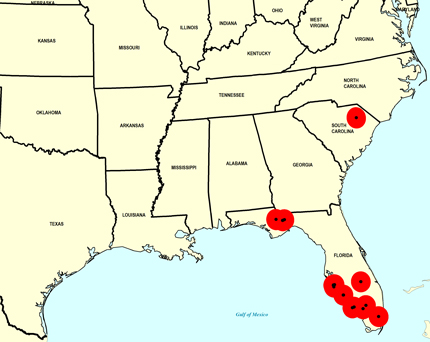
Calophos wilsoni
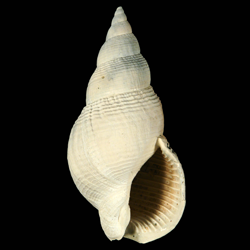
- Phylum: Mollusca
- Class: Gastropoda
- Order: Neogastropoda
- Family: Nassariidae
- Genus: Calophos
- Species: Calophos wilsoni (Allmon, 1990)
Geological Range
Late Pliocene; Extinct.
Paleogeographic Distribution
Southern Florida to South Carolina.
Remarks
Original Description (from Allmon, 1990, p. 75-76):
"Etymology of name. —Named in honor of Druid Wilson of the U. S. Geological Survey.
Diagnosis. — Medium to large Calophos with relatively high spire, rounded whorl profiles, and short columella. Axial sculpture very faint; spiral sculpture often obsolete over middle of body whorl. Columella separated from body whorl by unique combination of ridge and fold.
Description. — Moderate to very large for genus. Relative spire height comparable to most congeneric species, never exceeding approximately one-third total height. Protoconch consists of 1.25-l.5 rounded, unsculptured whorls. Boundary with teleoconch sharp and marked by initiation of clear axial and spiral ribbing. Axial sculpture on some specimens persists on spire whorls, on others quickly becomes obsolete. Observed teleoconch whorls seven to nine. Whorls rounded in profile and somewhat inflated. Sutures relatively deeply incised. Sculpture consists of numerous flat, evenly spaced ribs separated by shallow grooves. Ribs often become faint to obsolete over middle of body whorl, often only faint grooves persisting, or may persist undiminished. Axial sculpture present on body whorl usually only as faint, widely spaced ribs ending adapically as faint nodes slightly below suture and forming very weak shouldering of the body whorl. Aperture broadly lanceolate, approximately one-half total height. Posterior end shows slight notching. Inside of outer lip bears faint to moderate spiral ribs. Outer lip varies in thickness from thin but sturdy to quite thick. Parietal callus weak or absent. Columella relatively short; separated from body whorl by a distinct channel or crease, adapical to a strong spiral cord. Remainder of colu- mella bears five to seven evenly spaced spiral ribs, and ends in a distinct terminal fold. Anterior canal short and relatively wide.
Measurements (total height in mm). — Holotype, MCZ(IP) 29351, 36.0; Hypotype, (Olsson and Petit, 1964. pi. 79, fig. 6), 48.9.
Occurrence. — Florida. Sarasota and Charlotte counties, southwest to Dade County, "Pinecrest Formation" (type); Lee County, Jackson Bluff" Formation (Mansfield, 1930); (?) South Carolina, Sumter County, Duplin Formation (Campbell, 1974).
Range. — Lower-upper Pliocene.
Type locality. — APAC Florida Pit, northern Sarasota County, Florida, at junction of Interstate Highway 75 and Fruitville Road ("Pinecrest Formation").
Types. — Holotype, MCZ(IP) 29351; Paratype, MCZ(IP) 29350.
Other material examined.— VSNM stratigraphic collection: from USGS Iocs. 22298, 21907, Acline, Charlotte County, Florida; unnumbered specimens in the paleontological collections of the Department of Geology, University of South Florida, Tampa [total: 75 specimens].
Remarks.— This, the only North American representative of Calophos, most closely resembles C. plicatilis (Bose), but is larger, and has greater variability in the expression of axial and especially spiral sculpture over the body whorl. Spiral grooves may persist uniformly over the body whorl surface (as in the specimens figured by Olsson and Petit, 1964, pi. 79, fig. 6, and by Campbell, 1974), or become obsolete over this region (as in the holotype) in typical Calophos fashion. It closely resembles C. mixteca (Perrilliat Montoya, 1963), differing in being larger, relatively wider and having a relatively shorter columella. It is similar to C. ectyphus Woodring, 1964, but is larger and more elongate and has a somewhat thinner outer lip. C. wilsoni is characterized by a combination of features including short columella with a distinctive ridge-and-fold separating it from the body whorl, relatively high spire, rounded whorl shape with very faint to obsolete axial sculpture, and relatively large size.
No specimens from Jackson Bluff, Lee County, have been examined, and the only source of information on this occurrence is Mansfield (1930). Olsson and Petit (1964. p. 552) stated that this form is "fairly common at Acline, but rare at other Pinecrest localities." Their figured specimen came from a canal in Dade County. I have also examined specimens referable to C. wilsoni collected by E. J. Petuch at the "Bird Road Site" in Miami (see Petuch, 1986) from beds apparently equivalent to the "Pinecrest" beds at Sarasota. Among the many molluscan species they discuss, Olsson and Petit (1964, p. 517) single out this gastropod as being of particular interest, presumably because it so strongly indicates affinities with Caribbean and Central and South American faunas. Although the stratigraphic relations and nomenclatural status of the "Pinecrest" and the associated Caloosahatchee Formation remain unresolved (see Missimer, 1984, and Stanley, 1986, for summaries), a Pliocene date for the "Pinecrest" is well supported (e.g.. Akers, 1974)."
To access this description in its original formatting through the Biodiversity Heritage Library, click here.
Stratigraphic Occurrences
- Late Pliocene
- Jackson Bluff Formation (N. FL)
- Raysor Formation (SC)
- Tamiami Formation (S. FL)
- Tamiami Formation (Pinecrest Beds) (S. FL)
